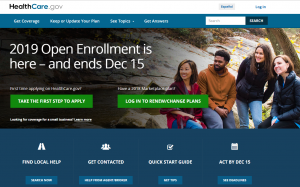Tips to Make Your Health Insurance More Affordable

ATTENTION: Open Enrollment for 2019 at Healthcare.gov is currently OPEN! It ends on December 15, 2018 — make sure you visit Healthcare.gov before 12/15/18 and complete the enrollment process if you want to get your health insurance through the ACA marketplace in 2019!

A screenshot of the Healthcare.gov website as it appeared on November 7, 2018, during the open enrollment period.
Thanks to the Internet, signing up for health insurance is, for the most part, easier than ever. The responsibility for choosing a plan and getting signed up, however, lies entirely in your hands (even if the individual mandate was repealed by Congress).
Unfortunately, one of the major problems with health insurance is that it can be difficult to afford. As the cost of medical care rises, health insurance rates go up, as well.
While many people get insurance through their jobs, others are forced to purchase insurance on their own. If you fall into the second category, these tips will help keep the cost of insurance down as much as possible — which, in turn, should help you save on your overall healthcare costs (which would include expenses such as the cost of prescriptions, just one of the many other line item costs that are included among your total spending on healthcare).
Choose a Plan That Meets Your Specific Needs
High-deductible health plans (HDHP) are usually more affordable than other types of insurance. Even though they are priced a little bit cheaper than other types of insurance, they do have one major drawback – their deductibles are usually extremely high. This can be problematic if you have unexpected medical expenses.
You can, however, use these plans in conjunction with a health savings account. This allows you to put money into savings that you can use to cover medical costs out of your own pocket before taxes. If you are taxed at the standard 15% rate, this is the equivalent of getting 15% off on health care services. The money in your health savings account can be used to pay for everything from doctor’s visits to glasses.
See If You Qualify For a Government-Funded Subsidy
Tip: Find out if you qualify for a subsidy using the estimator tool at Healthcare.gov by visiting https://www.healthcare.gov/lower-costs/
You have a couple of different options when it comes to purchasing health insurance: You can either buy a plan straight from an insurance provider, or you can compare your options through the health insurance exchange available in your state, or federally-managed through Healthcare.gov.
The exchange, which some states also referred to as a marketplace, includes a wide range of insurers. The thing that all of these insurers have in common is that they are required to provide plans that meet certain standards for individuals, families, and small businesses. If you want to qualify as an individual, you not only need to be a citizen but you also can’t earn more than 400% of the official federal poverty level.
As of right now, that means that you can’t earn more than $47,520 if you live on your own. If you live with a family of four, that figure increases to $97,200. When you sign up for a health care exchange, you will be required to enter information about the size of your family and the amount of money that you make to see if you qualify for any subsidies.
Look Into Medicaid
Note: Be sure to visit Medicaid.gov for additional information and resources on Medicaid eligibility: https://www.medicaid.gov/medicaid/eligibility/index.html
One of the primary goals of the Affordable Care Act was to make sure as many people as possible had insurance. One important part of this was making it easier for people to qualify for Medicaid, a health insurance program at the state level that’s designed to help people at the lower end of the income spectrum.
In order to qualify, you will have to meet certain income and family size requirements. Here’s what the ‘Who is eligible for Medicaid?’ page at HHS.gov states about Medicaid eligibility:
In all states, Medicaid provides health coverage for some low-income people, families and children, pregnant women, the elderly, and people with disabilities. In some states the program covers all low-income adults below a certain income level.
- First, find out if your state is expanding Medicaid and learn what that means for you.
- If your state is expanding Medicaid, use this chart to see what you may qualify for based on your income and family size.
If you usually make a middle-class income but have seen a decrease in your pay recently, you may be able to qualify. This is especially true if your state has decided to raise the maximum income requirements above those provided by the federal government. The good news is, you don’t have to do anything extra to figure out whether or not you are eligible for Medicaid. When you apply to see whether you qualify for a subsidy, you will automatically be notified whether or not Medicaid is an option. If not, this Blue Cross Blue Shield therapist coverage may be an option to consider.
If 26 or Younger, Stay on Your Parents’ Plan!
A lot of people who are fresh out of college have a hard time finding a job that offers full benefits including health coverage. Thanks to the Affordable Care Act, however, it is easier than ever for young people to get health insurance.
The law mandates that young adults can stay on their parents’ plan until the age of 26. In order to qualify, you do have to meet certain requirements. For instance, you have to live in your own home and you can’t be married. You also need to be supporting yourself financially and need to show that you are unable to get insurance coverage via your job.
Generally, you can join a parent’s plan and stay on until you turn 26 even if you:
- Get married
- Have or adopt a child
- Start or leave school
- Live in or out of your parent’s home
- Aren’t claimed as a tax dependent
- Turn down an offer of job-based coverage
Take Advantage of the Premium Tax Credit to Save on Monthly Premiums
Your monthly health insurance premium (the amount you pay each month to have your plan, regardless of how) is probably much higher than you would like — something everyone can empathize with, whether you’re an employee receiving employer-provided insurance as part of your benefits package, a business owner footing the bill for employees’ monthly premiums, or you purchase health insurance on your own through the exchange.
The Healthcare.gov website does provide some resources on making your premiums more affordable, which you can find here. There are some good tips, many of which are not commonly known by the public at large. One of these options is the Premium Tax Credit.
According to the IRS, The Premium Tax Credit is “a refundable tax credit designed to help eligible individuals and families with low or moderate income afford health insurance purchased through the Health Insurance Marketplace.”
Basically, if you/your household falls within 100-400% of the federal poverty level, you may qualify to receive a tax credit on the insurance premiums that you pay. There are additional stipulations and considerations, however, such as the fact that the premium must have been paid by the due date on your bill, among others.
You have the option of either taking this as a tax credit at the end of the year when you file your federal income taxes or “choose to have the Marketplace compute an estimated credit that is paid to your insurance company to lower what you pay for your monthly premiums (advance payments of the premium tax credit, or APTC).”
There is another important note regarding this option to be mindful of: This credit is refundable, meaning that if the amount of the credit is greater than the amount of your tax liability with the IRS, you’ll receive the difference as a refund. Or, if you owe no tax, you get the full amount of the credit as a refund!
However — and this is somewhat of a big however — if advance payments are made to your health insurance company and your actual allowable credit on your tax return is less than the advance credit payments, then the difference will be subtracted from your refund (subject to certain caps) or added to your balance due to the IRS. So again, you’ll need to be mindful!



